 John Mata Jr.
.
December 06, 2023
.
F100 Builders
John Mata Jr.
.
December 06, 2023
.
F100 Builders
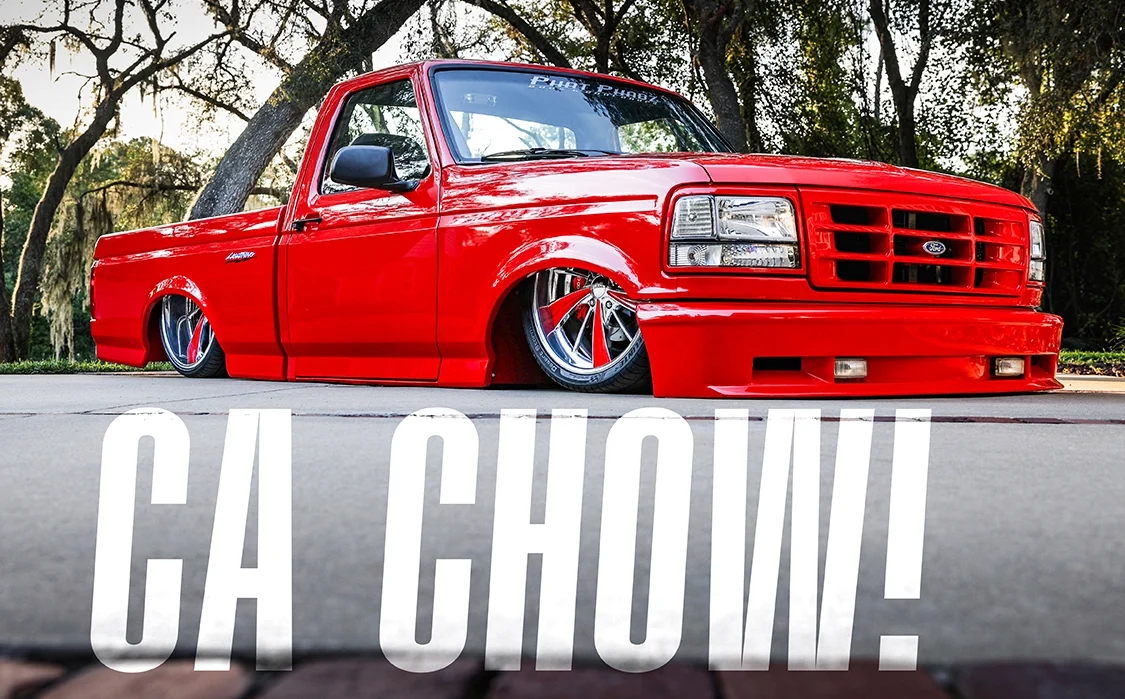
The Ford F-150 Lightning was and still is a very exciting performance-based pickup model. The inaugural 1993 first-gen model was introduced as a direct response to take on two hopped-up rivals in the OEM performance truck segment—the GMC Syclone and the Chevrolet 454SS. This was a grand time when consumers were introduced to a factory-direct combination of muscle car action in the shape of a pickup truck. Mix this in with the beginning stages of the custom sport truck scene in the early ’90s, and we had the makings of a perfect storm within the custom auto industry. The days of trucks serving as mere oafish utility vehicles were officially over from this era forward.
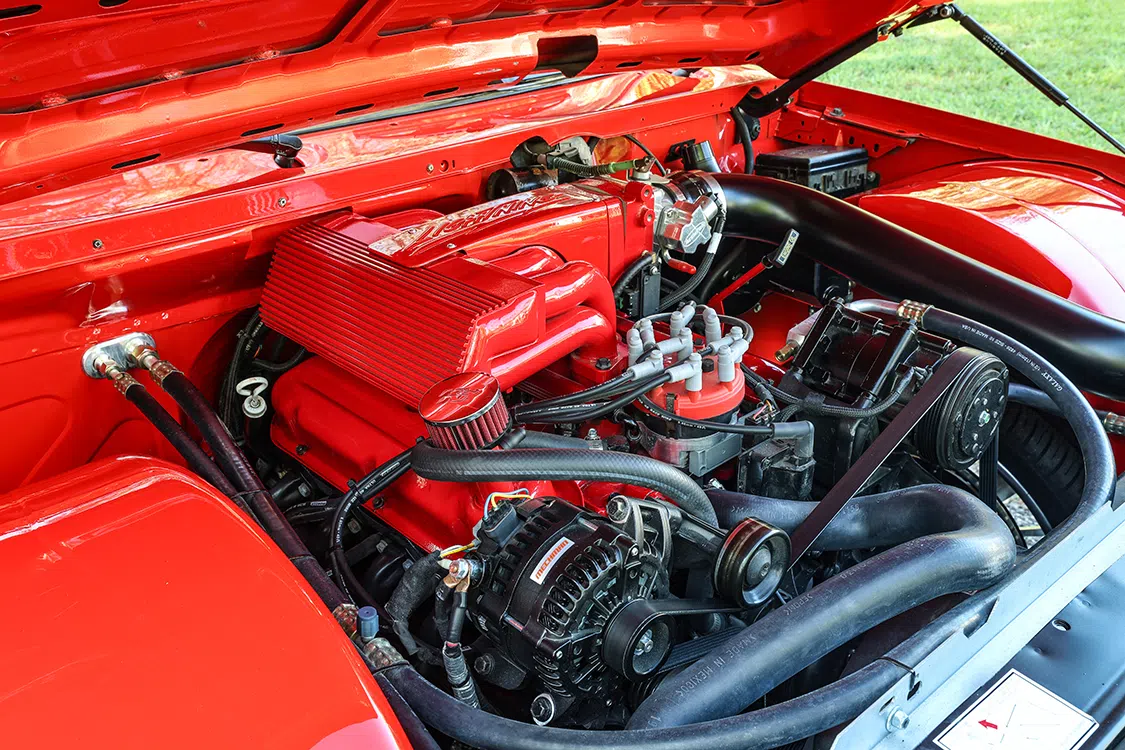
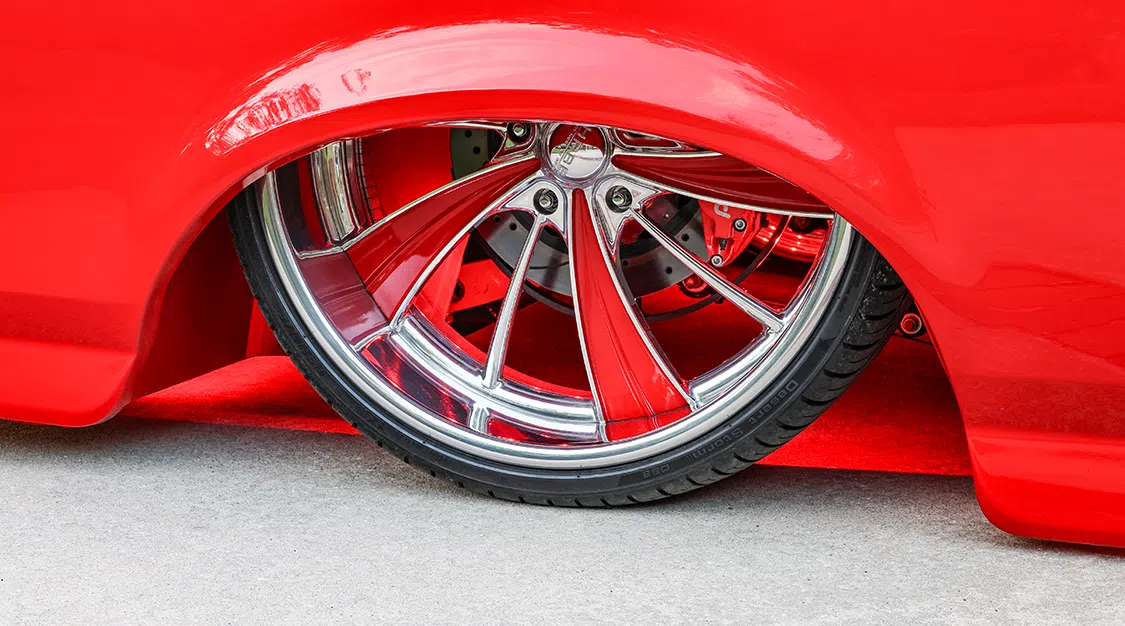
While many customized first-gen Ford Lightnings have surfaced since their initial release, we have yet to see an example of one built like the truck David Shulman and his daughter Madison have put together. Their ’93 is the epitome of throwback retro vibes fused with modern street aesthetics. Those familiar with David’s name know that he does not play around when it comes to the vehicles he chooses to buy and build. He’s a man who enjoys the finer things in life, and when the time comes to get down to work on a new ride, half measures are never taken.
There’s so much to love about this first-gen F-150 Lightning, and that sentiment has been evident across the board—including from GM purists.
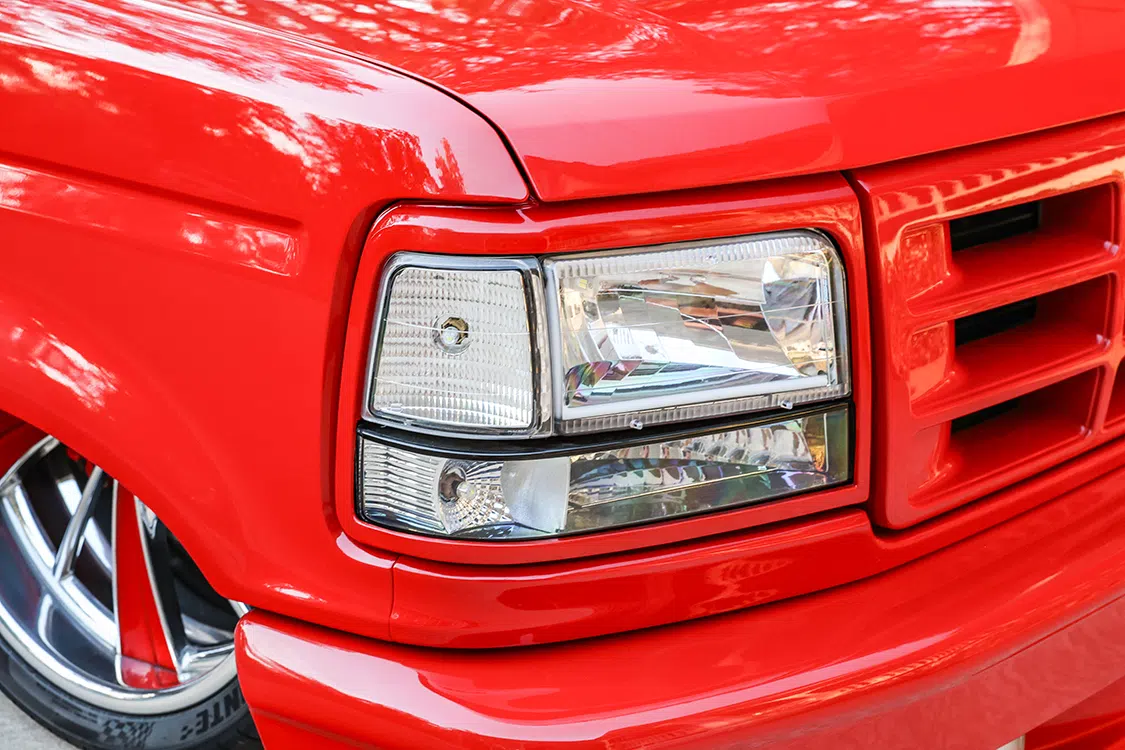
When David tracked down a Lightning he was interested in purchasing, he was relieved to find that it was parked somewhere in Florida that wasn’t too far from his front door. He would’ve had an issue venturing much farther out of his way to retrieve the truck if need be, but luck was on his side this time around. This afforded him the luxury of giving the truck a look in person without making much of an effort. What David found was a very clean, solid, and original 1993 Ford Lightning that had only see two previous owners. There really wasn’t a reason to not buy it, especially after negotiating a good starting price point that would work great for the full frame-off project he had envisioned.
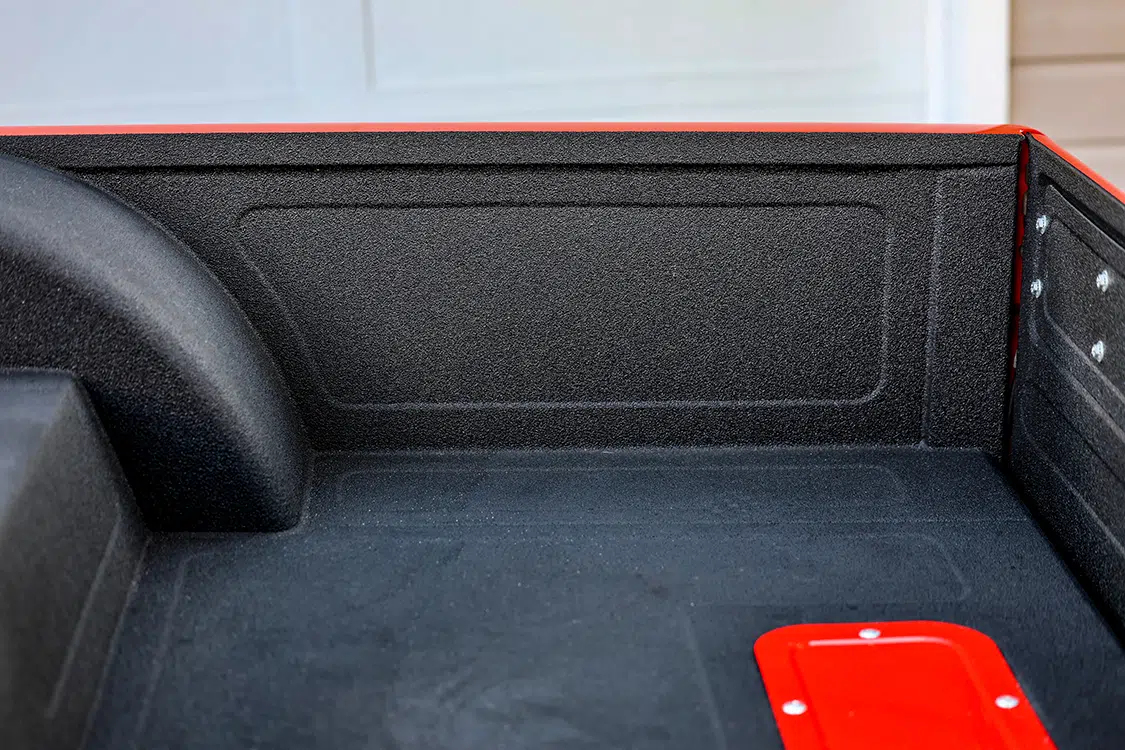
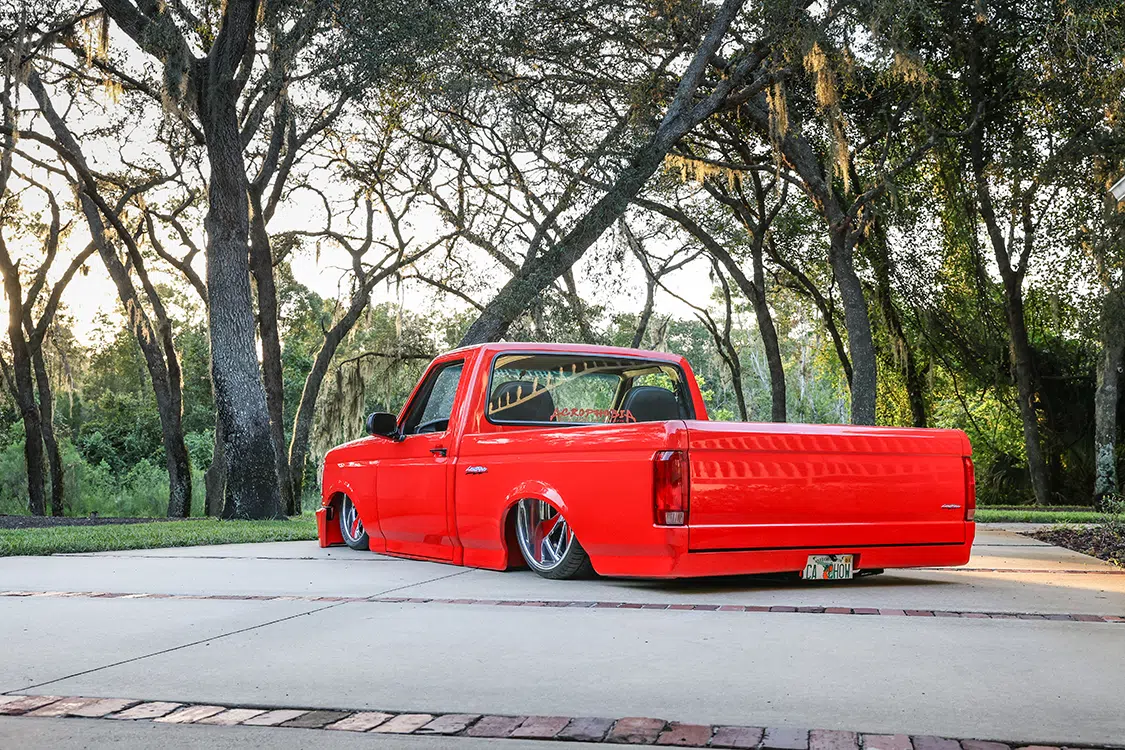
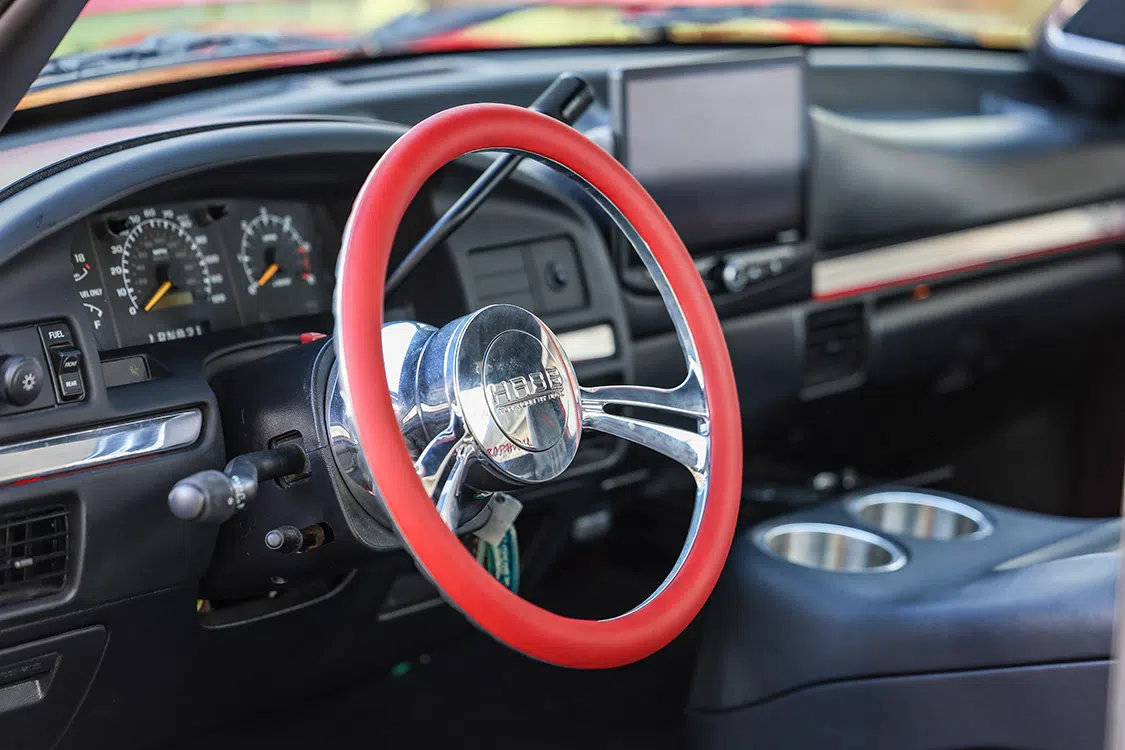
While the Lightning models come lowered about 2 inches from the factory, this ride height just wasn’t going to be low enough for David and Madison. With that in mind, they instead checked the Ford in with Jake McKiddie and the team at Phat Phabz in Choctaw, Oklahoma, for their full custom treatment, which would start with the fabrication of a full custom chassis. This front-to-back frame package features a lock-to-lock turning radius with adjustability of up to 14.5 inches of lift to free up large diameter wheels for unobstructed drivability. Front 2600 Air Lift Dominator air bags along with a parallel rear four-link setup topped with Firestone sleeve ‘bags make for comfortable cruising at just about any speed. This all comes with the highly desirable ability to lay the Lightning down on the ground, tucking the 22-inch front and 24-inch rear Hot Rods By Boyd wheels up into the body with ease.
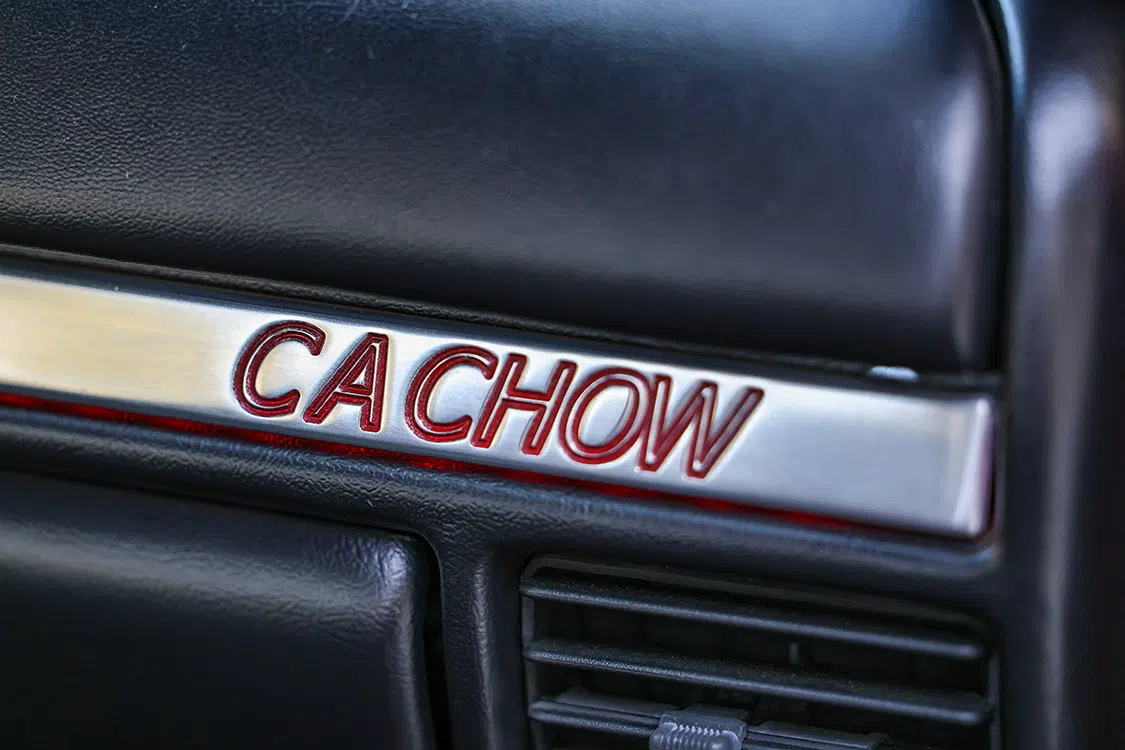
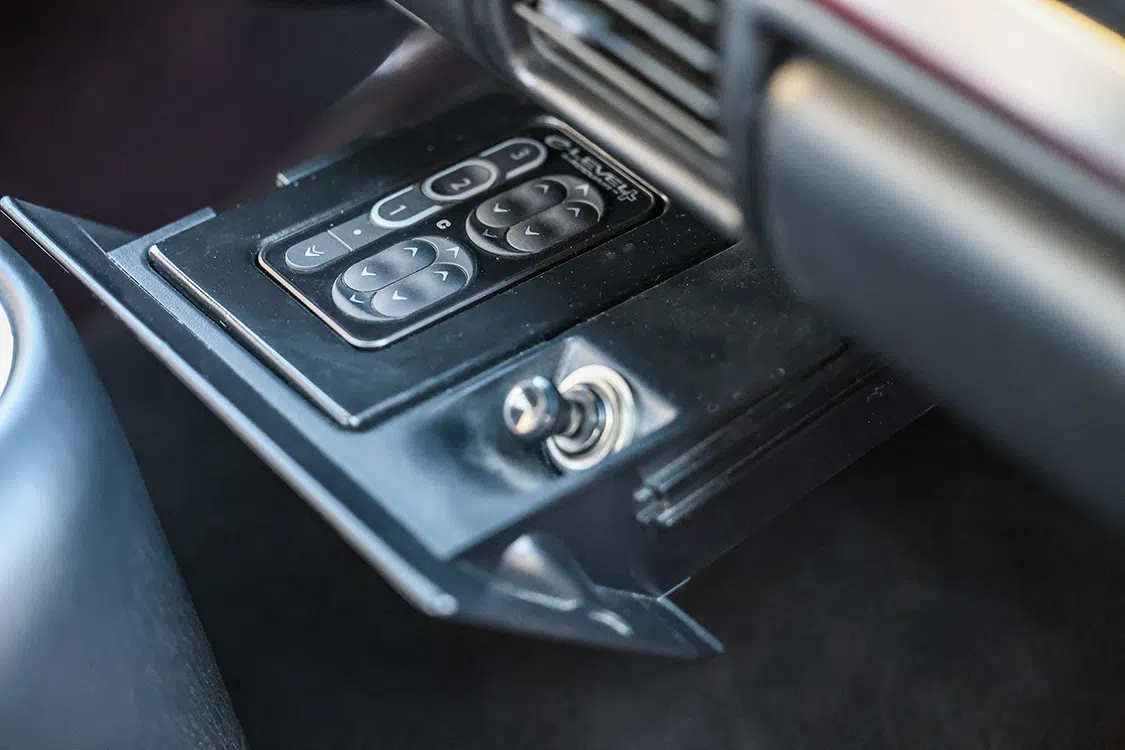
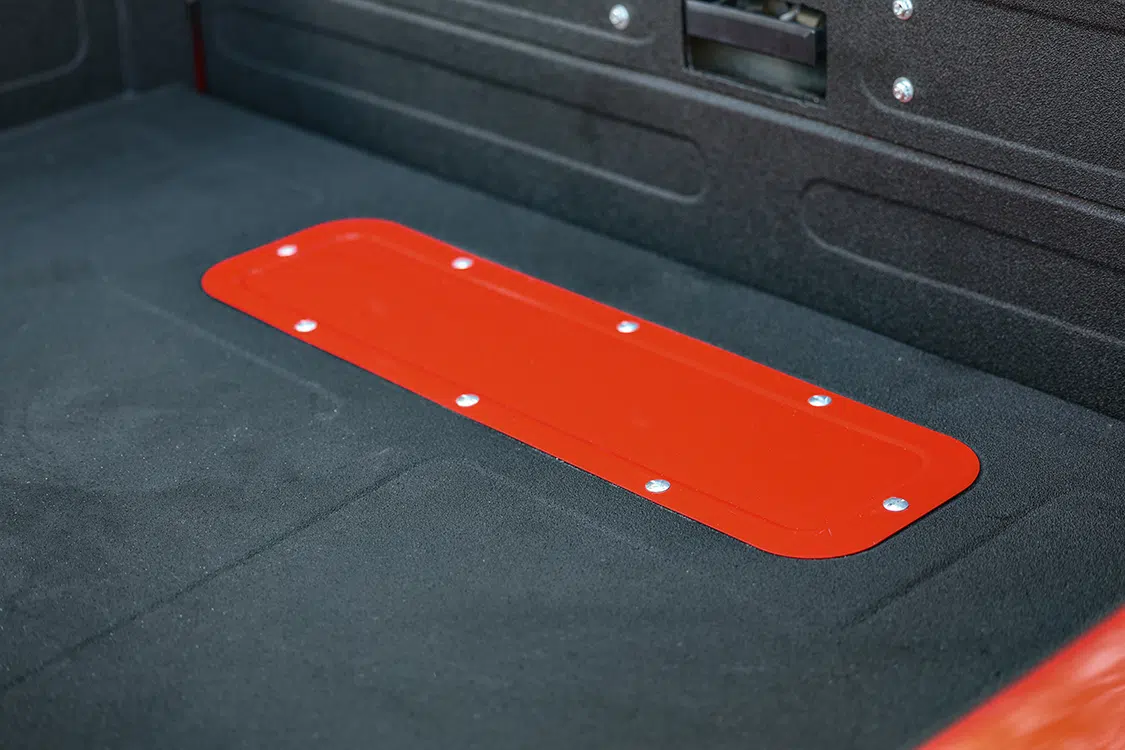
Building the frame from scratch bought David some time to arrange for the factory 5.8L engine to be plucked and rebuilt. To assist with this, he turned to Gerald Brand of Brand Racing Engines in Oklahoma City to tear the Lightning’s factory-equipped powerplant down and beef it up from the inside out. Along with the general gutting and cleaning process, Gerald outfitted the V-8 with Diamond pistons, Crower camshafts, Scorpion roller rocker arms and lifters, as well as created full custom air intake and exhaust systems. The result of the engine rebuild process netted a better-than-stock, still-numbers-matching engine that has the capability to rumble meaner than ever before.
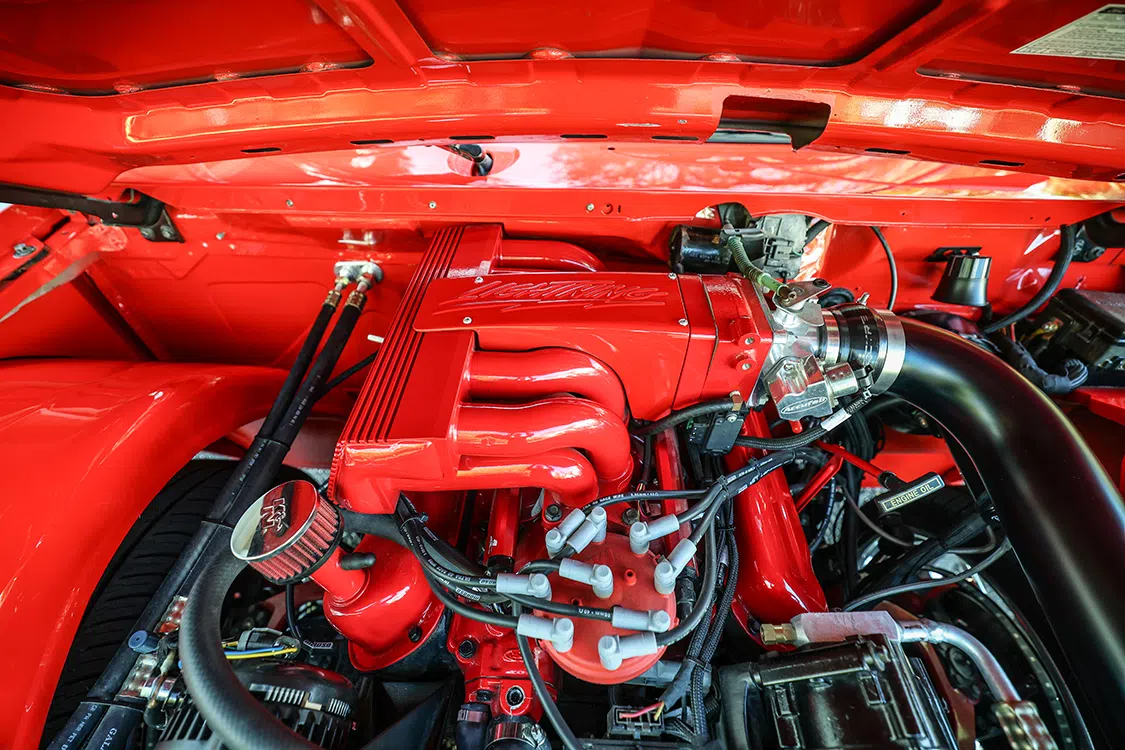
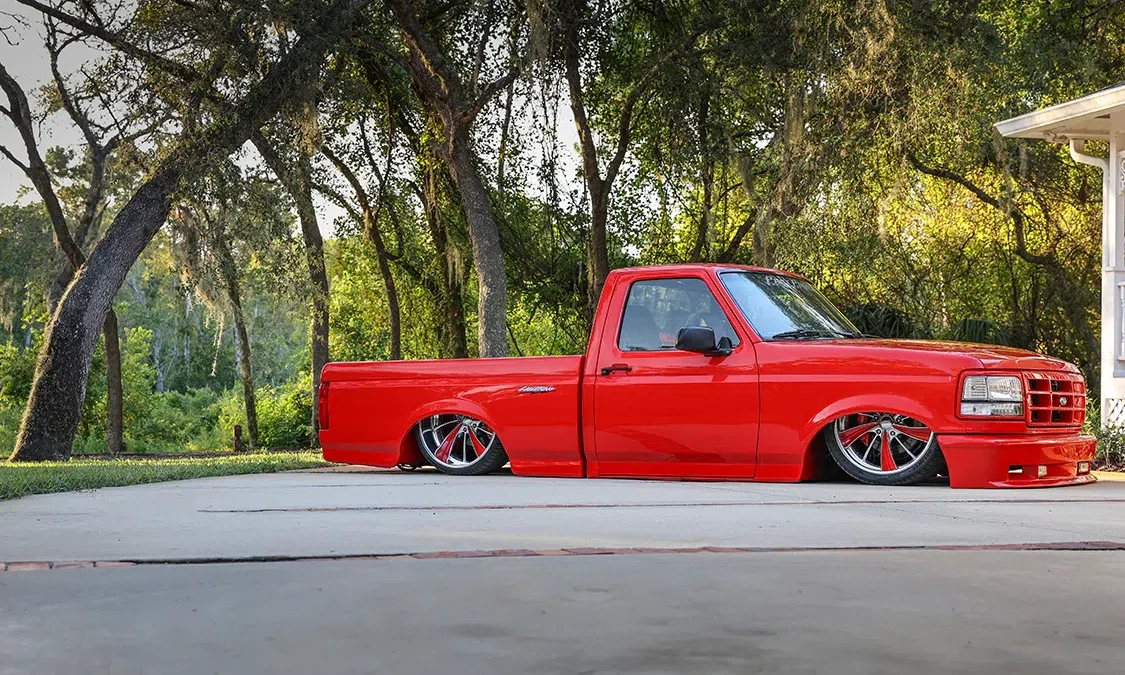
Before the engine was replanted underneath the hood, the bay was treated to a set of tubs and bodywork to get it prepped for its final stage of paint. The same process was also rolled out to the rest of the Ford’s exterior landscape, as the body was shaved clean of the drip rails, cab seams, and wiper cowl. These alterations, as labor intensive and necessary of a skilled hand as they are, cleaned up the Lightning’s façade enough without performing too many modifications. To further change up the frontend a few degrees, a custom front air dam/bumper was created, and a GrantFab roll pan was utilized to better round off the rear. These mods to the Ford gave David and Madison’s truck a one-of-a-kind appearance without calling attention to every single tweak that has gone into streamlining its appearance. Only those who are very familiarized with these first-gen Lightning models will pick up on everything included in the truck’s exterior restyling.
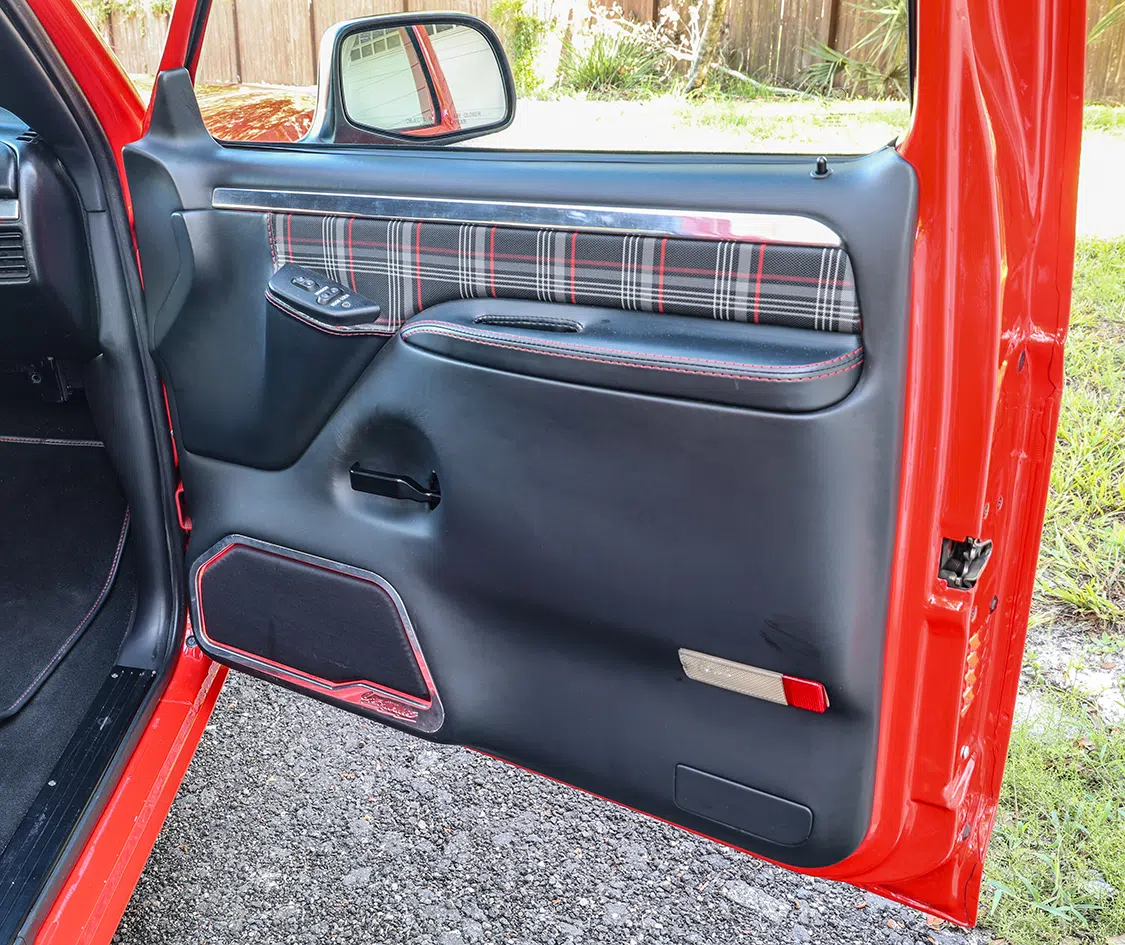
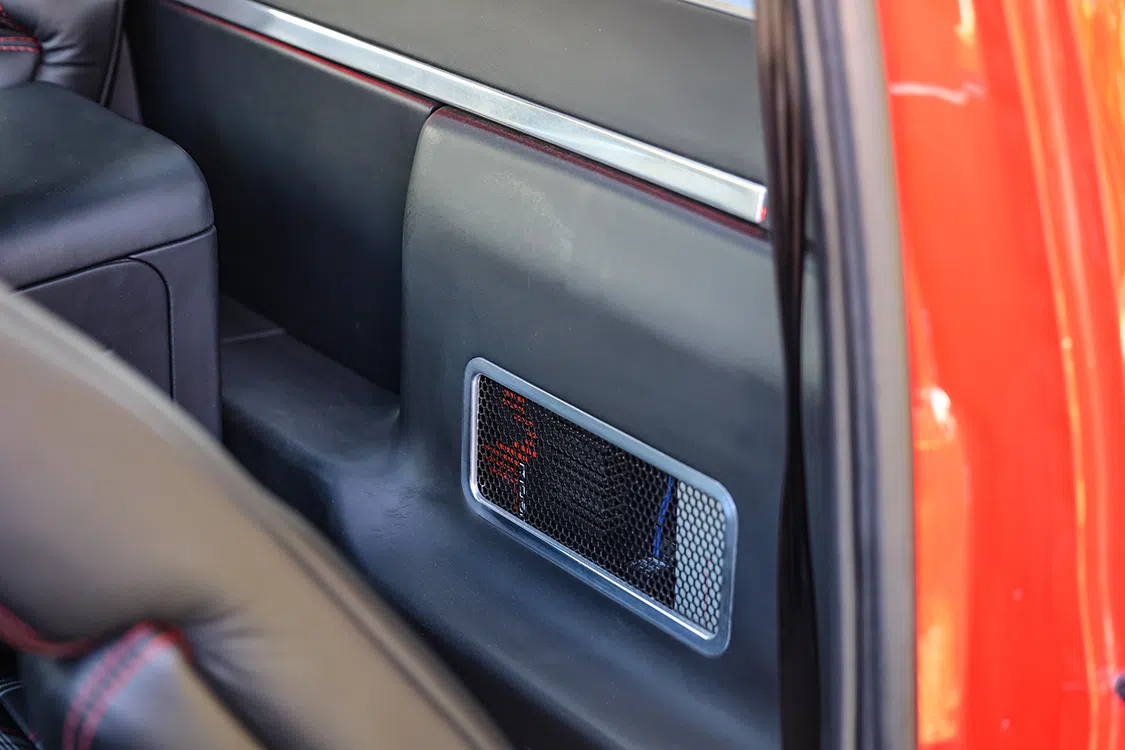
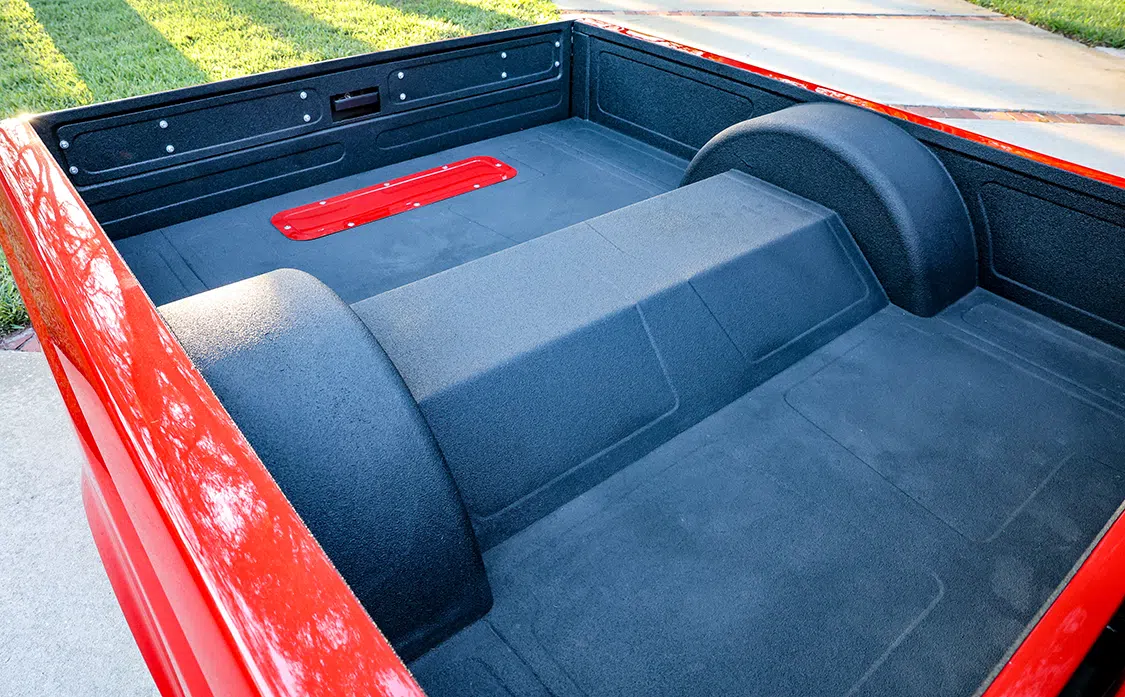
Since the F-150 Lightning was originally made available in red from the factory back in 1993, David felt that recovering the truck with a fresh coat of red paint would go a long way to staying true to the truck’s roots. Ryan Kidd at S&R Designs in Fort Smith, Arkansas, was approached to handle this portion of the project, and the color he suggested was Infra-Red from Orion Automotive Finishes—an excellent shade to run with. The color was also been applied inside of the engine bay, as well as on the large spokes on the wheels. When it came time to finish off the inside of the bed, the custom bead rolled panels that make up the walls and floor portions were coated in Line-X to give the Ford a contrasting pop of color while creating a useable cargo space to comfortably haul around valuable supplies or a stack of Christmas gifts from Santa.
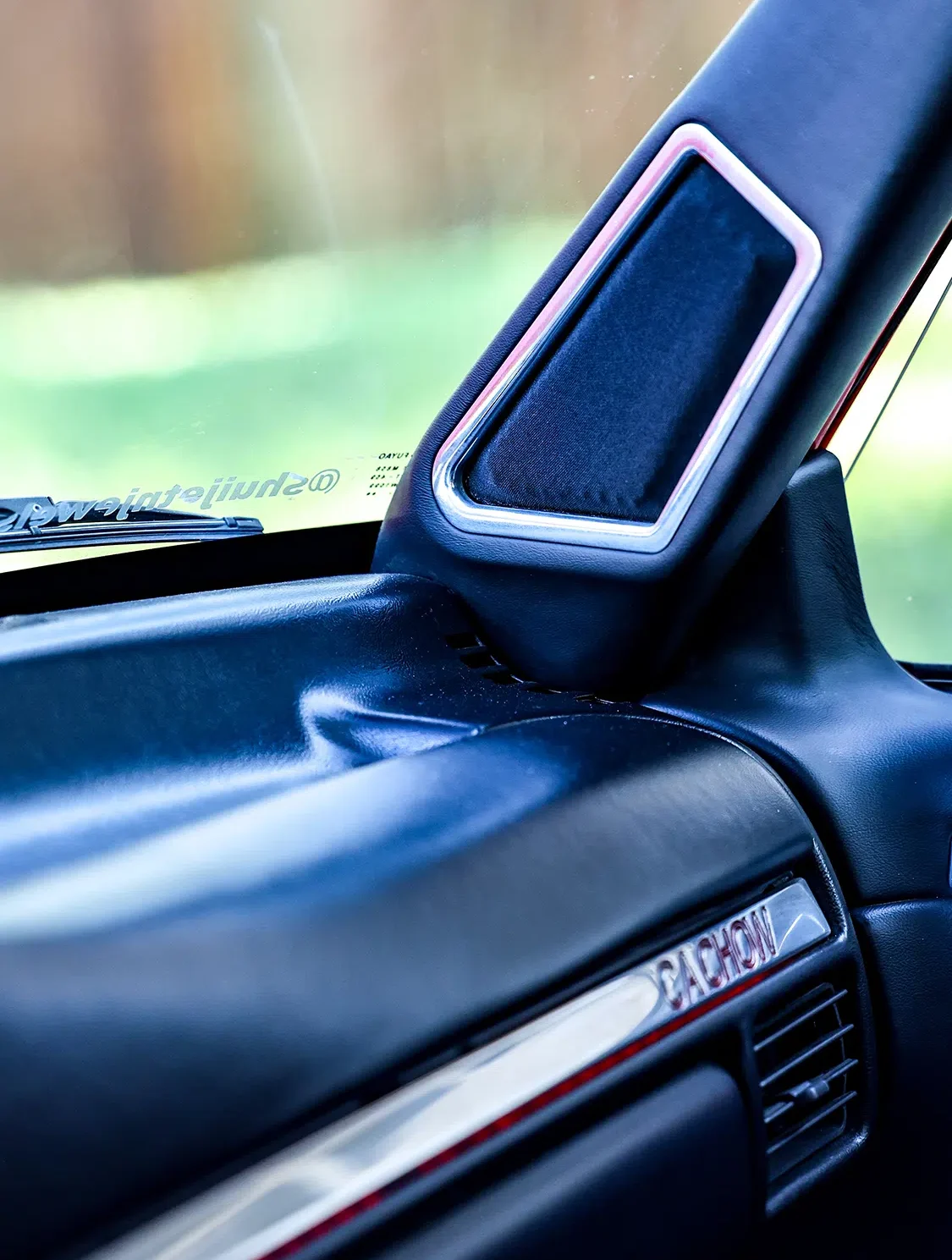
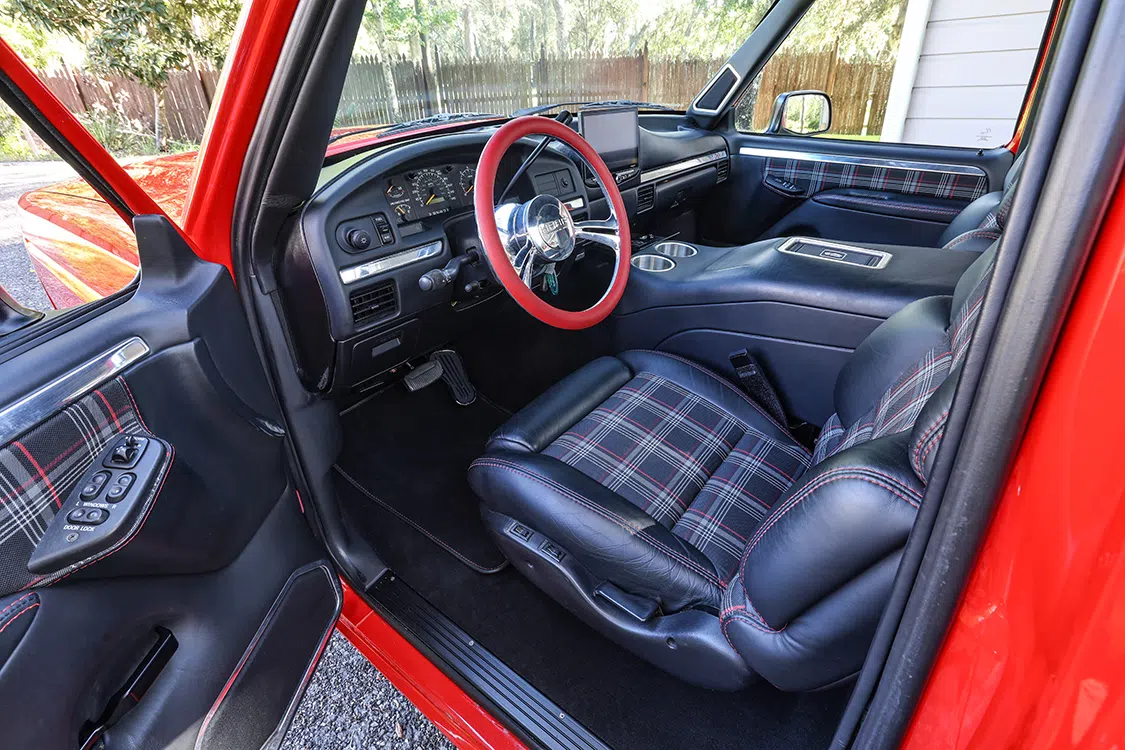
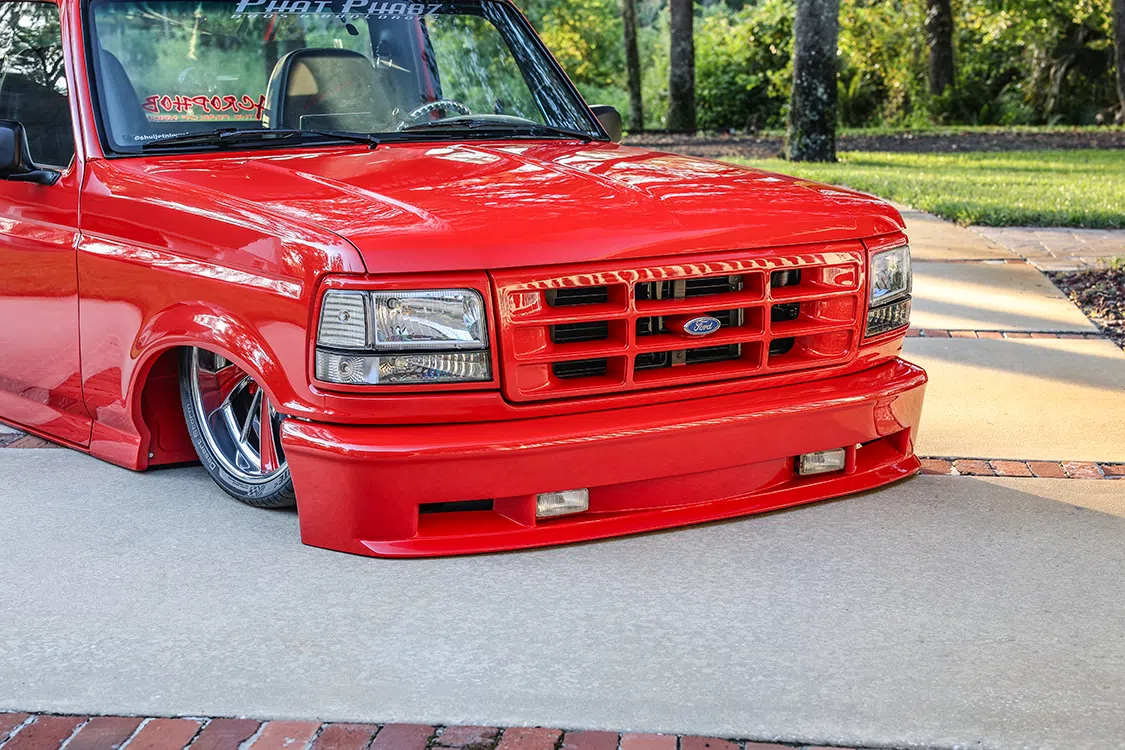
Instead of doubling down on the inclusion of red paint inside of the cab, the restyling of the interior takes a cue from the bed as far as the hues used. Aside from the wrapped Hot Rods by Boyd steering wheel, the majority of the cabin was done in black to promote a chill and subdued environment for cruising. Innerworx in Sarasota, Florida, joined the project to handle all the truck’s upholstery needs, and Eric Ryan at Advance Audio Concepts in Pompano Beach, Florida, lent a hand by customizing the dash as well as wiring up the full stereo system featuring a Stinger Heigh10 infotainment head unit. Since the weather can get a bit hot and humid for the Shulman family in Florida, working in a Restomod Air A/C system was an absolute must before the project was considered complete.
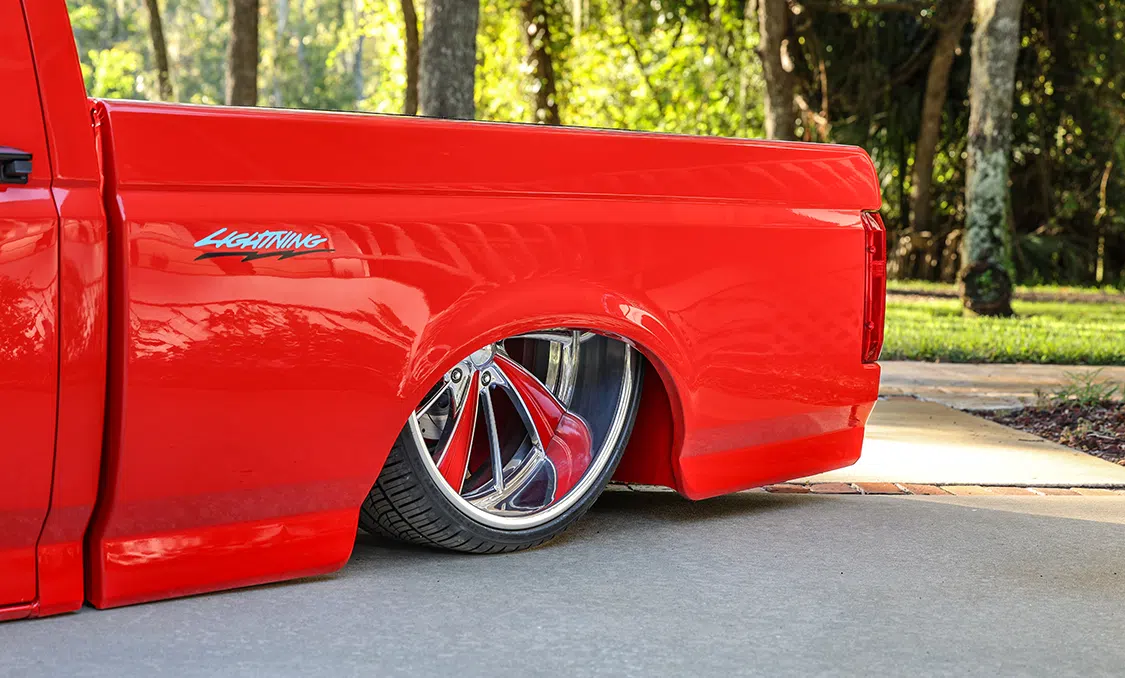
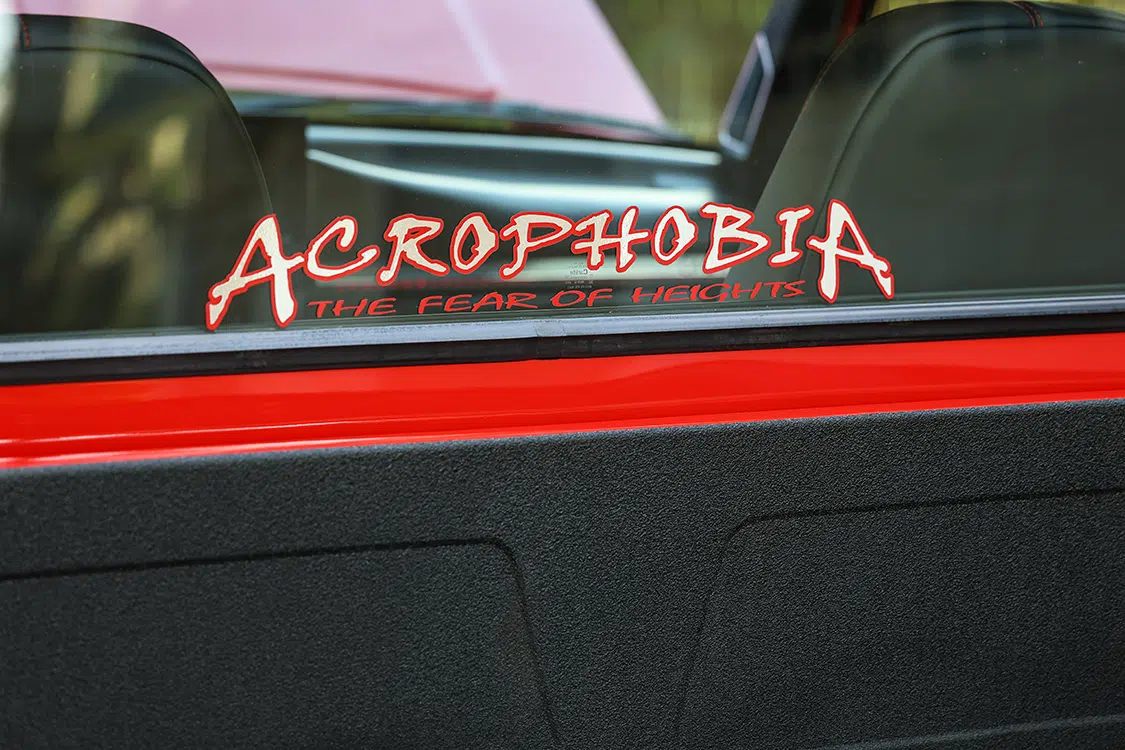
In right around nine months after the Lightning project kicked off, it was finished just in time to debut at SEMA 2022. The response from show attendees was extremely positive, which wasn’t a surprise to anyone involved in the build process. There’s so much to love about this first-gen F-150 Lightning, and that sentiment has been evident across the board—including from GM purists.
When it came time to finish off the inside of the bed, the custom bead rolled panels that make up the walls and floor portions were coated in Line-X to give the Ford a contrasting pop of color while creating a useable cargo space to comfortably haul around valuable supplies or a stack of Christmas gifts from Santa.
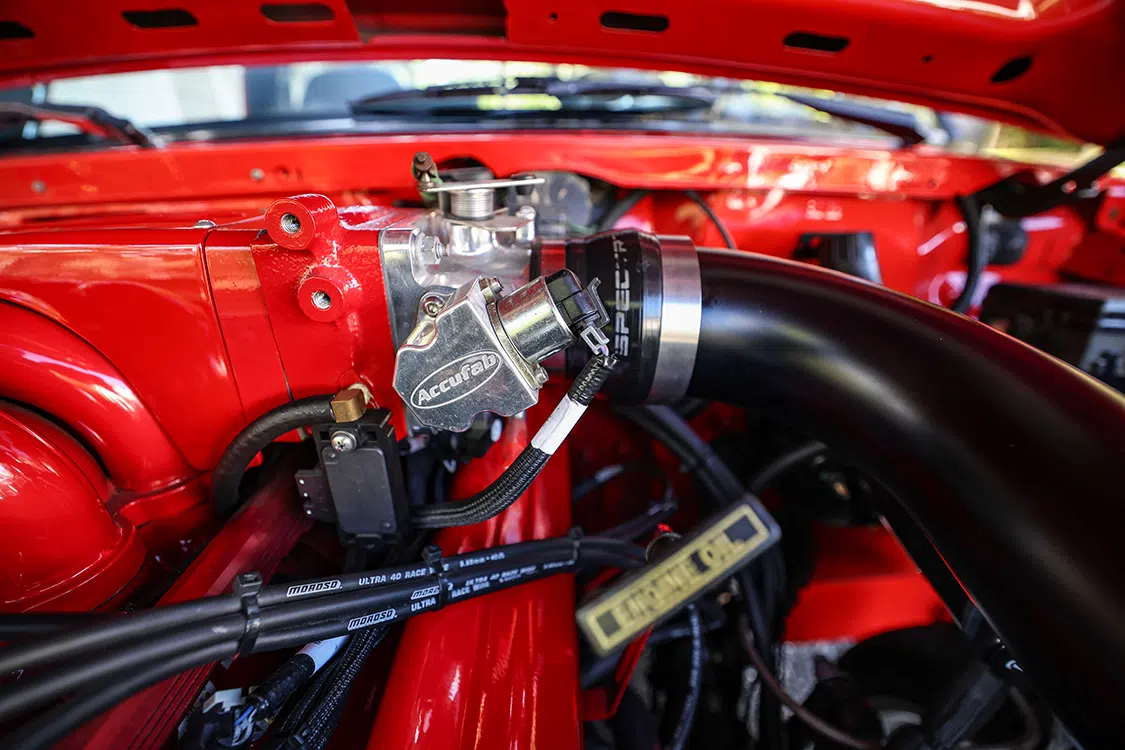
Madison wasn’t old enough to drive the truck back when it was first unveiled, but by the time you read this, she will have her license in hand. While we’re sure David has taught her to practice safe, responsible driving habits, we’d like to give others sharing the road with her a little slice of advice—don’t give her a reason to flex on you. Surely, she has gotten the hang of harnessing and unleashing the true power of her truck by now. Consider that your one and only warning.
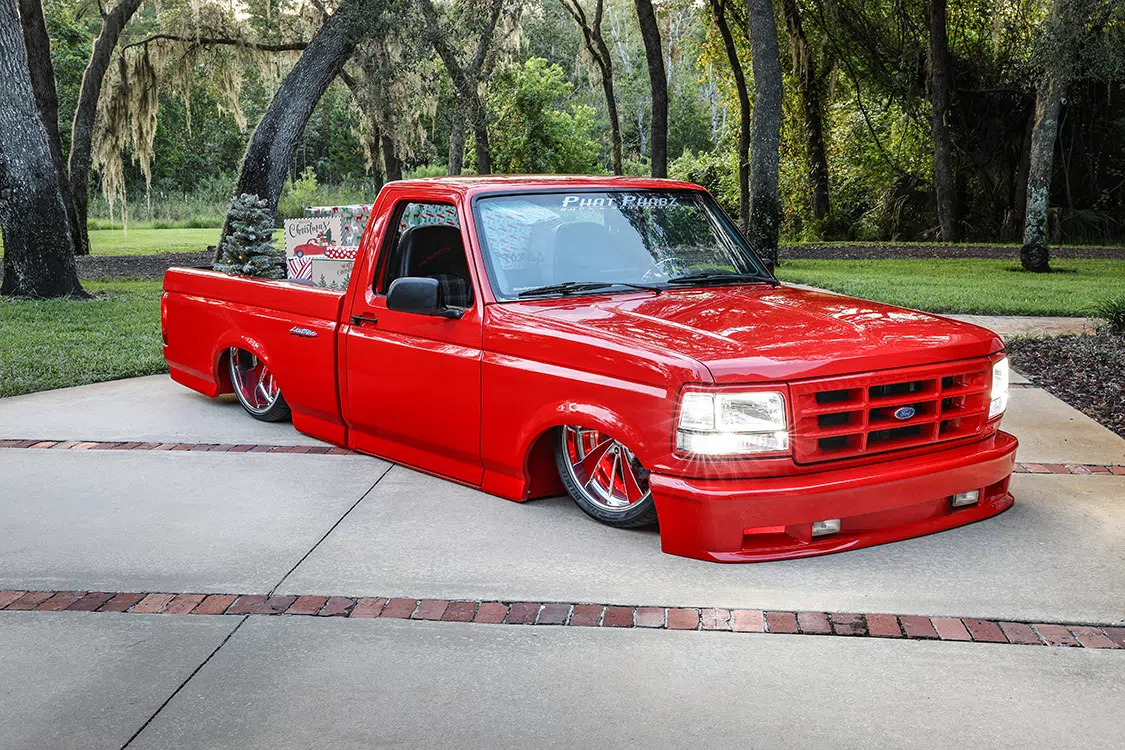
Owner
Engine & Drivetrain
Suspension
Wheels, Tires & Brakes
Body & Paint
Interior & Stereo
What were the chassis specifications, including dimensions and weight distribution, of the first-generation Ford Lightning?
The first-generation Ford Lightning was built to impress with its robust and precise chassis specifications. Here’s a detailed breakdown:
By combining a well-built frame with carefully considered dimensions and weight distribution, the first-generation Ford Lightning delivered both strength and stability on the road.
What were the key design philosophies and goals for the first-generation Ford Lightning?
The first-generation Ford Lightning was envisioned by a team of engineering and marketing professionals with a mission to create high-performance vehicles for enthusiasts. The key philosophy was to elevate existing models by refining their design and enhancing particular attributes. The primary goal was to transform these models into image leaders, showcasing advanced engineering and appealing aesthetics.
In essence, the first-generation Ford Lightning was designed to offer the performance of a sports car, famously summarized as a “Mustang GT with a cargo bed.” By focusing on these key design philosophies and goals, the vehicle successfully combined the robust utility of a truck with the spirited performance of a sportscar.
What were some of the interior features and options available on the first-generation Ford Lightning?
The first-generation Ford Lightning boasted a range of impressive interior features and optional upgrades, enhancing both comfort and functionality.
Designed initially for a bench seat or a 60/40 split bench, the interior left a gap between the seats. This gap could be filled with a plastic floor console from the same-generation Bronco. Additionally, a rare option included a console with a fold-down jump-seat.
The interior was based on the XLT trim, paired with a Preferred Equipment Package, which featured:
From 1993 to 1995, the Lightning’s standard interior features included a supplemental restraint system and, from 1994 onwards, a driver’s side airbag. Standard equipment also comprised:
The interior of the first-generation Ford Lightning was designed to combine luxury with practicality, offering a range of features and options that catered to diverse preferences.
What type of differential and rear axle were used in the first-generation Ford Lightning?
The first-generation Ford Lightning utilized a robust rear axle configuration tailored for performance. Specifically, it featured a 4.10:1-ratio rear axle paired with a limited-slip differential. This setup was housed in a heavy-duty 8.8-inch rear end that was filled with synthetic lubricant to ensure smooth operation and durability.
Additionally, the rear end assembly was uniquely designed for the Lightning model, incorporating external cooling fins. These fins played a crucial role in reducing temperatures during high-performance driving. The synthetic lubricant, although available for purchase, can be somewhat expensive but is essential for maintaining the rear end’s performance and longevity.
What type of transmission did the first-generation Ford Lightning use, and what were its specifications?
The first-generation Ford Lightning used an E4OD electronically controlled four-speed automatic transmission. This transmission was specially tuned to handle the increased power output of the Lightning. Key modifications included a recalibration for performance and the addition of an auxiliary oil cooler to ensure optimal operation under stress.
What is the history and background of muscle trucks like the Ford Lightning?
Muscle trucks, known for blending the robust power of muscle cars with the utilitarian appeal of pickups, have a history richer and longer than many might assume. While modern muscle trucks like the Ford Lightning and the SRT-10 Dodge have only achieved mainstream popularity recently, their roots extend back several decades.
Over 40 years ago, Dodge made a significant mark by introducing a 426-cubic-inch V8-powered Custom Sports Special D100 half-ton Sweptline. This model is often celebrated as the first instance of a personal muscle pickup, signaling the inception of a new vehicle category that combined the strength of a truck with the speed and agility of a muscle car.
Fast forward to the early 1990s, and the muscle truck scene was prepared for a resurgence. In 1993, Ford amplified this by launching the first generation of the Ford Lightning, developed by their Special Vehicle Team (SVT). This specialized team aimed to create high-performance versions of existing models, turning them into limited-edition favorites among automotive enthusiasts.
The design principles guiding these muscle trucks focused on refining existing models, enhancing their powertrains, and optimizing their chassis for a harmonious blend of power and control. The goal was to transform usual trucks into image leaders imbued with enhanced performance attributes.
Key attention was directed towards balancing the Lightning’s power and handling capabilities. The result was a pickup truck that, in the words of its creators, could be likened to a Mustang GT with a cargo bed. This not only positioned the Ford Lightning as a high-performance vehicle but also expanded the concept of what a pickup truck could achieve in terms of speed and agility.
Today, muscle trucks resonate well beyond their initial niche, innovating continuously and welcoming new iterations that push the boundaries of their capabilities. The groundwork laid by early models like the Dodge D100 and the Ford Lightning has paved the way for a diverse range of high-performance pickups, merging muscle car prowess with practical utility.
From their inception in the 1960s to the sophisticated engineering marvels they are today, muscle trucks have carved out a unique and enduring place in automotive history.
What are the standard interior measurements and equipment for the first-generation Ford Lightning?
Standard Interior Measurements and Equipment for the First-Generation Ford Lightning
These features collectively provided a comfortable and well-equipped cabin experience for the first-generation FordLightning.
What were the body features and available colors for the first-generation Ford Lightning?
The first-generation Ford Lightning boasted a durable, welded, all-steel body, ensuring robustness and longevity. A notable feature was its color-coordinated rear step bumper, which could be upgraded to a tubular one, enhancing its aesthetic appeal. The front end featured a color-matched grille, headlamp bezels, and bumper, integrated with an air dam and fog lamps for improved visibility and a sportier look.
Available Colors
(Note: Neither color included a clearcoat.)
If encountering a green 1993 model, it’s advisable to be cautious since these were not original factory colors offered at the time.
What platform was the first-generation Ford Lightning built on, and what were some of the changes made over the years?
The first-generation Ford Lightning was constructed on the truck platform spanning from 1987 to 1995. Over the three years of its availability, the model saw several updates.
In total, 11,563 units of the first-generation Lightnings were produced, reflecting a variety of aesthetic and technical changes throughout its production span.
The first-generation Ford Lightning came equipped with dual fuel tanks that together could hold an impressive 34.7 gallons of gasoline. When it comes to refueling, you’d currently need about $100 to fill the tanks with regular unleaded gas. Regarding towing and payload capacities, the truck was designed to handle a maximum payload of 745 pounds and could tow up to 5,000 pounds.
Who was responsible for the design and development of the first-generation Ford Lightning?
The responsibility for the design and development of the first-generation Ford Lightning rested with Ford’s Special Vehicle Team (SVT). This specialized division brought together experts in engineering and marketing. Their primary mission was to create high-performance, limited-edition vehicles aimed at enthusiasts, using existing models as their base.
The SVT team focused on refining the design and enhancing the features of current Ford models. Their goal was not only to improve performance but also to elevate these vehicles to become leaders in Ford’s image portfolio. By honing in on these specific aspects, the team ensured the Lightning was a standout in both performance and aesthetic appeal.
What reproduction parts are available for the first-generation Ford Lightning, and which are no longer produced?
Available and Unavailable Reproduction Parts for First-Generation Ford Lightning
For enthusiasts restoring a first-generation Ford Lightning, there are several reproduction parts accessible. Phoenix Graphix offers a Lightning logo kit, though it’s important to note that this kit doesn’t include the retroreflective Lightning bolt. Many core components, especially those related to the engine, can still be found at well-stocked auto parts stores.
However, some parts are no longer in production and may be more challenging to find. Notably, the Firestone Firehawk GTA P275/60HR17 blackwall tires are discontinued and there are no aftermarket reproductions available at this time. This lack of replacement tires poses a significant hurdle for restorers aiming for authenticity.
In summary, while essential engine parts and some reproduction accessories are available, specific items like the original tires are no longer produced, requiring restorers to seek alternative solutions.
What kind of wheels and tires came standard on the first-generation Ford Lightning?
The first-generation Ford Lightning came equipped with 17-inch by 8-inch aluminum wheels, designed for both performance and aesthetic appeal. These wheels were matched with P275/60HR17 blackwall tires, ensuring a robust grip and smooth ride.
These specifications were carefully chosen to enhance the vehicle’s handling and overall performance.
What were the production totals and color breakdowns for the first-generation Ford Lightning from 1993 to 1995?
Let’s explore the production numbers and color distribution for the first-generation Ford Lightning from 1993 to 1995.
Across these three years, the first-generation Lightning saw a total production run of 11,563 units. The color variety shifted slightly over the years, with black as the most produced color overall, followed by red and then white.
How can you verify the authenticity of a Ford Lightning using the VIN?
To ensure you are truly purchasing an authentic Ford Lightning and not merely an F-150 with Lightning features, you’ll need to examine the Vehicle Identification Number (VIN) closely. Here’s a step-by-step guide:
By following these steps, you can confidently verify the authenticity of a Ford Lightning, ensuring you get exactly what you’re paying for.
What were the performance metrics, such as horsepower, torque, and acceleration times, of the first-generation Ford Lightning?
The Ford F-150 Lightning was and still is a very exciting performance-based pickup model. The inaugural 1993 first-gen model was introduced as a direct response to take on two hopped-up rivals in the OEM performance truck segment—the GMC Syclone and the Chevrolet 454SS. This was a grand time when consumers were introduced to a factory-direct combination of muscle car action in the shape of a pickup truck. Mix this in with the beginning stages of the custom sport truck scene in the early ’90s, and we had the makings of a perfect storm within the custom auto industry. The days of trucks serving as mere oafish utility vehicles were officially over from this era forward.
Performance-wise, the first-generation Ford Lightning was no slouch. The powerplant could produce 0-60 times of 7.2 seconds, 0-100 mph in 25.7 seconds, and cover the quarter mile in 15.6 seconds at 87.4 mph. Lightning output resulted in a then very healthy 240hp at 4,200 rpm and 340 lbs-ft of torque at 3,200 rpm. Top speed was electronically limited to 110 mph. However, the EPA fuel economy left something to be desired at 12 mpg city and 16 mpg highway.
Building the frame from scratch bought David some time to arrange for the factory 5.8L engine to be plucked and rebuilt. To assist with this, he turned to Gerald Brand of Brand Racing Engines in Oklahoma City to tear the Lightning’s factory-equipped powerplant down and beef it up from the inside out. Along with the general gutting and cleaning process, Gerald outfitted the V-8 with Diamond pistons, Crower camshafts, Scorpion roller rocker arms and lifters, as well as created full custom air intake and exhaust systems. The result of the engine rebuild process netted a better-than-stock, still-numbers-matching engine that has the capability to rumble meaner than ever before.
What performance parts and modifications can be made to enhance the engine of the first-generation Ford Lightning?
Building the frame from scratch bought David some time to arrange for the factory 5.8L engine to be plucked and rebuilt. To assist with this, he turned to Gerald Brand of Brand Racing Engines in Oklahoma City to tear the Lightning’s factory-equipped powerplant down and beef it up from the inside out. Along with the general gutting and cleaning process, Gerald outfitted the V-8 with Diamond pistons, Crower camshafts, Scorpion roller rocker arms and lifters, as well as created full custom air intake and exhaust systems. The result of the engine rebuild process netted a better-than-stock, still-numbers-matching engine that has the capability to rumble meaner than ever before.
In addition to these high-quality components, several other performance modifications can significantly enhance the first-generation Ford Lightning’s engine:
By combining these detailed performance modifications with the high-quality rebuild components, David’s Lightning not only retains its numbers-matching authenticity but also gains a significant boost in power and efficiency, making it a beast on the road.
What are the specifications and features of the engine used in the first-generation Ford Lightning?
The first-generation Ford Lightning’s engine is a marvel of engineering, meticulously designed for performance and reliability. Based on the 5.8-liter, 351-cu.in. Engine, it boasted an 8.8:1 compression ratio, a 4-inch bore, and a 3.50-inch stroke. The stock hydraulic flat-tappet camshaft featured a duration at 0.50 (intake 200 degrees and exhaust 214 degrees), with an advertised duration of 260 degrees intake and 274 degrees exhaust.
SVT engineers enhanced the engine with GT-40-type cast-iron cylinder heads, a tuned intake manifold, and tubular stainless-steel headers. Larger intake (1.84-inch) and exhaust valves (1.54-inch), high-flow ports, and revised combustion chambers further optimized airflow and combustion efficiency. The high-rate capacity fuel pump, injectors, and a redesigned air filter for improved airflow were also integral components.
Special high-silicon aluminum hypereutectic pistons and a custom camshaft were used for optimized valve tuning. To maintain optimal oil temperatures, a cartridge-type oil-to-water exchanger was installed. The engine’s computer control was finely tuned to deliver crisp throttle response while maintaining acceptable fuel economy.
Performance metrics were impressive for its time, with the engine producing 240 hp at 4,200 rpm and 340 lb-ft of torque at 3,200 rpm. It could accelerate from 0-60 mph in 7.2 seconds, reach 0-100 mph in 25.7 seconds, and cover the quarter-mile in 15.6 seconds at 87.4 mph. Top speed was electronically limited to 110 mph, and EPA fuel economy was rated at 12 mpg city and 16 mpg highway.
The Lightning distributor used a special cap made of Rynite, known for its high dielectric properties, and is the recommended cap for maintaining optimal engine performance. Combining these specifications with modern enhancements like the Holley Terminator X 65mm throttle body and a rebuilt transmission with a shift kit, this engine setup offers a unique blend of original design and contemporary performance.
What are some recommended upgrades for the chassis and suspension of the first-generation Ford Lightning?
While the Lightning models come lowered about 2 inches from the factory, this ride height just wasn’t going to be low enough for David and Madison. With that in mind, they instead checked the Ford in with Jake McKiddie and the team at Phat Phabz in Choctaw, Oklahoma, for their full custom treatment, which would start with the fabrication of a full custom chassis. This front-to-back frame package features a lock-to-lock turning radius with adjustability of up to 14.5 inches of lift to free up large diameter wheels for unobstructed drivability. Front 2600 Air Lift Dominator air bags along with a parallel rear four-link setup topped with Firestone sleeve ‘bags make for comfortable cruising at just about any speed. This all comes with the highly desirable ability to lay the Lightning down on the ground, tucking the 22-inch front and 24-inch rear Hot Rods By Boyd wheels up into the body with ease.
But before diving into such extensive modifications, it’s crucial to understand the robust foundation of the first-generation Ford Lightning. This iconic truck came with a full, ladder-welded steel frame, doubled at the kick-up and rails measuring 0.170 inches. The standard chassis featured a true dual stainless steel exhaust system with four catalytic converters, two mufflers, and two tailpipes that exited behind the passenger wheel.
The front suspension was standard F-150 fare with twin I-beams, augmented by a one-inch anti-roll bar to maintain stability. The rear suspension included a rigid axle and leaf springs, as you’d expect from a pickup, with the entire suspension lowered by 2.5 inches from stock. Monroe Formula GP gas units with a 1.375-inch bore served as the front shocks, while both front and rear anti-roll bars measured 1 inch.
Understanding these detailed specifications gives a clearer picture of the foundational strength and performance capabilities of the first-generation Ford Lightning. Whether you’re considering modest tweaks or full-blown customizations like David and Madison, knowing what you’re starting with is key to achieving the best results.
What were the suspension and brake systems like in the first-generation Ford Lightning?
The front suspension features standard F-150 components, utilizing twin I-beams. To enhance stability, a one-inch anti-roll bar is incorporated. The front shocks are Monroe Formula GP gas units with a 1.375-inch bore. For the rear, it employs a rigid axle and leaf springs, maintaining the traditional pickup design. Both front and rear anti-roll bars measure 1 inch, and the entire suspension is lowered 2.5 inches from stock. The leaf springs are constructed with a single leaf for simplicity and reliability.
Each Lightning is equipped with power steering, featuring an integral recirculating ball type with a 17.0:1 ratio. The steering system has been upgraded with a larger Pitman arm and an improved-response power steering control valve, ensuring precise handling and control.
The braking system consists of a power-assisted front disc/rear drum setup with anti-lock brakes on the rear wheels only. The front rotors measure 11.72 inches in diameter, while the rear drums are 11.03 inches x 2.25 inches wide. This configuration enables the Lightning to come to a complete stop from 60 mph in just 143 feet, providing strong and reliable braking performance.
What are the characteristics of the new muscle cars or sport trucks in Middle America?
The new muscle cars, known today as sport trucks, possess a unique blend of power and style that’s captivating Middle America. These vehicles are designed with unmistakable strength, showcasing an aggressive stance and eye-catching aesthetics. Here’s what sets them apart:
In essence, these sport trucks are redefining what it means to be a modern muscle car, marrying classic power with contemporary design to create a driving experience that’s as exhilarating as it is iconic.
What are the performance differences between the Ford F-150 Lightning and the Chevrolet 454SS?
When comparing the performance of the Ford F-150 Lightning and the Chevrolet 454SS, several key differences stand out, stemming from the depth of development and design focus.
Overall, while the Chevrolet 454SS thrives on raw power and traditional truck strength, the Ford F-150 Lightning excels through refined performance, smoother driveline operations, and enhanced handling, positioning it as the more agile and responsive option.
How do the Ford F-150 Lightning and Chevy 454SS compare as full-sized megapower sport trucks?
When it comes to full-sized megapower sport trucks, two vehicles often steal the spotlight. Here’s how they stack up against each other in terms of performance, design, and driving experience.
Ford F-150 Lightning:
Chevy 454SS:
Ford F-150 Lightning:
Chevy 454SS:
Ford F-150 Lightning:
Chevy 454SS:
Ford F-150 Lightning:
Chevy 454SS:
The Ford F-150 Lightning emerges as the more refined sport truck, thanks to its sophisticated drivetrain, superior handling, and comfortable interior. However, the Chevy 454SS remains a strong contender with its raw power and traditional appeal. Fans of torque-heavy performance might still find their match in the Chevy, though the Fordclearly takes the crown in this heavyweight battle.
What specific issues are noted with the Ford F-150 Lightning, such as wind noise and front axle design?
When evaluating the Ford F-150 Lightning, there are two primary concerns that stand out.
These issues highlight areas where the driving comfort and control could be improved in the Ford F-150 Lightning.
How do the observed and EPA fuel economy ratings compare for the Ford F-150 Lightning and Chevrolet 454SS?
When evaluating the fuel efficiency of pickup trucks, it’s important to consider both observed and EPA(Environmental Protection Agency) ratings. Let’s break down the numbers for the Ford F-150 Lightning and the Chevrolet 454 SS to see how they stack up against each other.
The difference between observed and EPA ratings indicates the variability in fuel consumption depending on driving habits and conditions. While the EPA estimates suggest it can achieve up to 17 mpg on the highway, real-world usage tends to align more closely with city figures.
For the Chevrolet 454 SS, the observed figures closely match the EPA’s estimates, especially in city conditions, pointing to a more consistent performance across different environments.
In comparison, the Ford F-150 Lightning generally performs better on the highway, achieving a higher EPA rating of 17 mpg compared to the Chevrolet 454 SS’s 12 mpg. However, in everyday driving situations, both trucks see a closer performance, with the Ford averaging 12 mpg and the Chevrolet about 10 mpg. This assessment helps potential buyers understand how these trucks may perform in real-world settings beyond just theoretical calculations.
How does the Ford F-150 Lightning’s interior compare to that of the Chevrolet 454SS?
When you step inside the Ford F-150 Lightning, you’ll notice a distinct shift towards a more car-like ambiance compared to its Chevy counterpart, the 454SS.
In summary, the F-150 Lightning steps up the game with a driver-focused, elegant interior that prioritizes comfort and style, despite offering no additional space compared to the Chevrolet 454SS.
What are the specifications and test results for the 1993 Chevrolet 454SS?
1993 Chevrolet 454 SS Specifications and Test Results
The 1993 Chevrolet 454 SS is a robust front-engine, rear-wheel-drive pickup designed to seat two passengers. This classic 2-door model combines power with solid performance, embodying the muscle truck vibe of the early ’90s.
Equipped with a 4-speed automatic transmission, the 454 SS ensures a smooth driving experience, handling the truck’s formidable power effectively.
This performance-driven pickup stands out for its blend of power and classic styling, making it a memorable piece of automotive history.
How does the Chevrolet 454SS perform in terms of torque and handling?
When it comes to torque, the Chevrolet 454SS does not disappoint. With over 400 pound-feet generated at a mere 2400 rpm, this truck responds eagerly to any acceleration demand. A simple press of the gas pedal results in a swift and powerful surge, showcasing its potent performance capabilities right from the get-go.
In terms of handling, the 454SS offers an intriguing experience. It’s engineered to exhibit understeer, providing stability and control during most driving conditions. However, push it harder around a corner, and you’ll witness a seamless transition into oversteer. This characteristic becomes even more pronounced on wet roads, where the vehicle’s rear can be swung out with vigor, allowing drivers to navigate turns with throttle precision.
While maintaining its identity as a truck, the 454SS surprises with its sporty handling. However, it’s important to note that its dynamics are best appreciated when the bed isn’t loaded with heavy cargo, like two cords of firewood. Ultimately, in rural settings where trucks are valued for their robustness and versatility, the handling quirks of the 454SS are an asset rather than a drawback.
How does the Chevrolet 454SS handle braking and ride quality on different road surfaces?
When it comes to braking, the Chevrolet 454SS presents a mixed bag. It requires a lengthy 217 feet to come to a stop from 70 mph, with a pedal that’s somewhat soft, making it tricky to achieve smooth, controlled stops. Additionally, while the truck is equipped with anti-lock brakes in the rear, these can sometimes lock up unexpectedly, adding to the challenge.
As for ride quality, this truck offers a unique experience. The ZQ8 sport suspension package, featuring higher-rate springs, Bilstein shocks, and robust BFGoodrich tires, allows the 454SS to handle moderately well on smooth roads. However, when it encounters uneven surfaces like rutted gravel, comfort declines significantly. The ride can become particularly jarring, to the point where it once caused the passenger armrest to come loose during testing.
In urban settings or well-maintained roads, the truck’s gentle oscillations provide a relatively smooth experience, though not quite as disciplined as some of its competitors. On the whole, the Chevrolet 454SS is best suited for smoother roads, where its sporty suspension setup can shine without being undermined by rough terrain.
What are the pros and cons of the Chevrolet 454SS’s interior and design features?
When exploring the interior and design characteristics of the Chevrolet 454SS, several pros and cons stand out that define the overall user experience.
These points summarize the main strengths and limitations of the Chevrolet 454SS’s interior, highlighting areas both of comfort and potential frustration for drivers and passengers alike.
What factors contributed to the decline in sales of the Chevrolet 454SS?
In the early 1990s, the Chevrolet 454SS saw a sharp decline in sales, with numbers dropping to around a thousand units each in 1991 and 1992. Several factors contributed to this downturn:
These elements combined led to the Chevrolet 454SS’s declining sales, ultimately resulting in its discontinuation.
What are the performance attributes and potential future of high-performance trucks?
Muscle trucks, known for blending the robust power of muscle cars with the utilitarian appeal of pickups, have a history richer and longer than many might assume. While modern muscle trucks like the Ford Lightning and the SRT-10 Dodge have only achieved mainstream popularity recently, their roots extend back several decades.
Over 40 years ago, Dodge made a significant mark by introducing a 426-cubic-inch V8-powered Custom Sports Special D100 half-ton Sweptline. This model is often celebrated as the first instance of a personal muscle pickup, signaling the inception of a new vehicle category that combined the strength of a truck with the speed and agility of a muscle car.
Fast forward to the early 1990s, and the muscle truck scene was prepared for a resurgence. In 1993, Ford amplified this by launching the first generation of the Ford Lightning, developed by their Special Vehicle Team (SVT). This specialized team aimed to create high-performance versions of existing models, turning them into limited-edition favorites among automotive enthusiasts.
The design principles guiding these muscle trucks focused on refining existing models, enhancing their powertrains, and optimizing their chassis for a harmonious blend of power and control. The goal was to transform usual trucks into image leaders imbued with enhanced performance attributes.
Key attention was directed towards balancing the Lightning’s power and handling capabilities. The result was a pickup truck that, in the words of its creators, could be likened to a Mustang GT with a cargo bed. This not only positioned the Ford Lightning as a high-performance vehicle but also expanded the concept of what a pickup truck could achieve in terms of speed and agility.
Today, muscle trucks resonate well beyond their initial niche, innovating continuously and welcoming new iterations that push the boundaries of their capabilities. However, the journey hasn’t been without challenges. The high-performance attributes found in these vehicles are often subjected to the compromises inherent in dual-purpose missions. For instance, Chevrolet’s foray into this market segment showed initial promise but was met with dwindling sales, highlighting the volatility and niche nature of this segment.
Some industry observers remain skeptical about the future of high-performance trucks, questioning whether these vehicles can successfully merge the attributes of speed and utility. The historical fluctuations in sales figures indicate that despite their passionate fan base, these trucks face an uphill battle in achieving widespread market penetration.
From their inception in the 1960s to the sophisticated engineering marvels they are today, muscle trucks have carved out a unique and enduring place in automotive history. As new models continue to emerge, they must navigate the delicate balance of performance and practicality to secure their place in the future automotive landscape.
What additional insights or mysteries are present in the market for high-performance trucks?
There is an underlying curiosity about whether manufacturers, such as Ford with their new entries, possess undisclosed insights or strategies that may influence the market differently, suggesting room for innovation or change despite past challenges.
What strategic decisions are manufacturers making in response to market performance?
In response to declining sales figures, manufacturers like Chevrolet have decided to cease production of their high-performance truck model, indicating a strategic pivot away from this niche market segment due to its lack of sustained success.
What challenges are associated with combining high-performance attributes with dual-purpose vehicles like trucks?
The main challenge lies in successfully merging sports car-like performance with the practical, dual-purpose nature of trucks. This involves overcoming inherent compromises and creating a vehicle that satisfies both performance enthusiasts and practical users.
What is the industry’s current stance on the future of high-performance trucks?
There is skepticism within the industry regarding the future viability of high-performance trucks. Some experts do not foresee a promising future for these vehicles, suggesting that the market may not sustain long-term interest or demand.
What are the sales trends for high-performance trucks?
High-performance trucks initially showed promise, as evidenced by Chevrolet’s strong sales in 1990, selling 13,748 units. However, this success was short-lived, with sales plummeting to about a thousand units in both 1991 and 1992, indicating a rapid decline in consumer interest or market saturation.
What are the specifications and test results for the 1993 Ford F-150 Lightning?
The first-generation Ford Lightning’s engine is a marvel of engineering, meticulously designed for performance and reliability. Based on the 5.8-liter, 351-cu.in. Engine, it boasted an 8.8:1 compression ratio, a 4-inch bore, and a 3.50-inch stroke. The stock hydraulic flat-tappet camshaft featured a duration at 0.50 (intake 200 degrees and exhaust 214 degrees), with an advertised duration of 260 degrees intake and 274 degrees exhaust.
SVT engineers enhanced the engine with GT-40-type cast-iron cylinder heads, a tuned intake manifold, and tubular stainless-steel headers. Larger intake (1.84-inch) and exhaust valves (1.54-inch), high-flow ports, and revised combustion chambers further optimized airflow and combustion efficiency. The high-rate capacity fuel pump, injectors, and a redesigned air filter for improved airflow were also integral components.
Special high-silicon aluminum hypereutectic pistons and a custom camshaft were used for optimized valve tuning. To maintain optimal oil temperatures, a cartridge-type oil-to-water exchanger was installed. The engine’s computer control was finely tuned to deliver crisp throttle response while maintaining acceptable fuel economy.
Performance metrics were impressive for its time, with the engine producing 240 hp at 4,200 rpm and 340 lb-ft of torque at 3,200 rpm. It could accelerate from 0-60 mph in 7.2 seconds, reach 0-100 mph in 25.7 seconds, and cover the quarter-mile in 15.6 seconds at 87.4 mph. Top speed was electronically limited to 110 mph, and EPA fuel economy was rated at 12 mpg city and 16 mpg highway.
The Lightning distributor used a special cap made of Rynite, known for its high dielectric properties, and is the recommended cap for maintaining optimal engine performance. Combining these specifications with modern enhancements like the Holley Terminator X 65mm throttle body and a rebuilt transmission with a shift kit, this engine setup offers a unique blend of original design and contemporary performance.
This comprehensive look at the 1993 F-150 Lightning provides a perfect blend of detailed specifications and performance insights, making it a standout in both its original and modified forms.
What is the observed and EPA-rated fuel economy?
The observed fuel economy is 12 mpg, while the EPA rates it at 14 mpg combined, 12 mpg city, and 17 mpg highway.
What are the specific tire details?
The truck is equipped with Firestone Firehawk GTA tires, sized P235/60HR-17 for both the front and rear.
What are the detailed test results for performance metrics?
The truck reaches 60 mph in 7.2 seconds, completes a quarter-mile in 15.8 seconds at 86 mph, and hits 100 mph in 25.7 seconds. The top speed is 110 mph, braking from 70-0 mph takes 184 feet, and it achieves 0.88 g on a 300-ft skidpad.
What are the full dimensions of the truck?
The truck has a wheelbase of 116.8 inches, a length of 201.8 inches, a width of 79.0 inches, and a height of 68.9 inches. The cab volume is 62 cubic feet.
What is the price of the 1993 Ford F-150 Lightning?
The base price was $19,523, and the price as tested was $21,782.
What are the strengths and weaknesses of the Ford F-150 Lightning’s handling and braking performance?
While the Lightning models come lowered about 2 inches from the factory, this ride height just wasn’t going to be low enough for David and Madison. With that in mind, they instead checked the Ford in with Jake McKiddie and the team at Phat Phabz in Choctaw, Oklahoma, for their full custom treatment, which would start with the fabrication of a full custom chassis. This front-to-back frame package features a lock-to-lock turning radius with adjustability of up to 14.5 inches of lift to free up large diameter wheels for unobstructed drivability. Front 2600 Air Lift Dominator air bags along with a parallel rear four-link setup topped with Firestone sleeve ‘bags make for comfortable cruising at just about any speed. This all comes with the highly desirable ability to lay the Lightning down on the ground, tucking the 22-inch front and 24-inch rear Hot Rods By Boyd wheels up into the body with ease.
But before diving into such extensive modifications, it’s crucial to understand the robust foundation of the first-generation Ford Lightning. This iconic truck came with a full, ladder-welded steel frame, doubled at the kick-up and rails measuring 0.170 inches. The standard chassis featured a true dual stainless steel exhaust system with four catalytic converters, two mufflers, and two tailpipes that exited behind the passenger wheel.
The braking system consists of a power-assisted front disc/rear drum setup with anti-lock brakes on the rear wheels only. The front rotors measure 11.72 inches in diameter, while the rear drums are 11.03 inches x 2.25 inches wide. This configuration enables the Lightning to come to a complete stop from 60 mph in just 143 feet, providing strong and reliable braking performance.
To further appreciate the Ford Lightning’s capabilities, it’s essential to delve into its handling dynamics. Known for its superior drivetrain refinement, the Lightning offers a smoother transmission experience. While its upshifts are slightly slower, the downshifts are remarkably responsive, interpreting even mild pedal inputs as a call for more acceleration. This responsiveness enhances the driving experience, particularly when navigating winding roads or executing swift maneuvers.
The Lightning’s handling prowess is complemented by its braking performance. While the pedal feel may have a slightly squashy nature, it delivers a positive and assured stopping power. The Lightning’s braking system allows for confident control, making it a standout in performance metrics, with lateral acceleration figures and lane-change times reflecting its agility.
Overall, the Ford Lightning combines a robust foundation with enhanced handling and braking capabilities, making it a formidable presence on the road. Whether in its factory form or with custom modifications, this truck is engineered to deliver an exceptional driving experience.
What is the braking performance like?
The braking system of the Lightning is superior, with a more responsive pedal, although it retains a slightly soft feel.
How is the driver’s environment?
The Lightning features a more refined and comfortable driver’s environment, enhancing overall driving pleasure.
How does the ride quality compare to competitors?
The Ford Lightning provides a more comfortable ride than the Chevy, making it a preferable choice for a smoother driving experience.
What is the comparative refinement of the drivetrain?
The Lightning boasts superior drivetrain refinement compared to its Chevy counterpart, offering a more polished driving experience.
How does the transmission perform during upshifts and downshifts?
The Ford Lightning’s transmission is smooth, although slightly slower in upshifts, and excels in downshifts by responding eagerly to acceleration demands.
Share Link